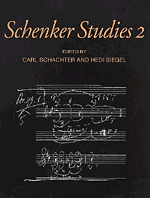Book contents
- Frontmatter
- Contents
- Abbreviated references to Schenker's writings
- Preface
- ARCHIVAL STUDIES
- Levels of understanding: an introduction to Schenker's Nachlass
- When “Freier Satz” was part of Kontrapunkt: a preliminary report
- Schenker's unpublished work with the music of Johannes Brahms
- ANALYTICAL STUDIES
- Index
When “Freier Satz” was part of Kontrapunkt: a preliminary report
Published online by Cambridge University Press: 12 January 2010
- Frontmatter
- Contents
- Abbreviated references to Schenker's writings
- Preface
- ARCHIVAL STUDIES
- Levels of understanding: an introduction to Schenker's Nachlass
- When “Freier Satz” was part of Kontrapunkt: a preliminary report
- Schenker's unpublished work with the music of Johannes Brahms
- ANALYTICAL STUDIES
- Index
Summary
In January of 1920, Schenker wrote a letter to his friend August Halm. The letter includes the following passage:
Most important for me is II2 [the second book of Kontrapunkt], in which the voice leading of free composition and its complete identity with that of so-called strict counterpoint is uncovered and demonstrated. “Semper idem, sed non eodem modo” penetrates into every section: the torchlight from this same motto emanates from strict counterpoint in three voices, shines upon counterpoint in four and more voices, upon combinations of the species, and then upon free composition. Here it continues to illuminate the sections on scale degrees, composing-out, voice leading, parallel fifths and octaves, the passing tone, the suspension, keyboard style and abbreviations, thorough bass, the chorale, etc., etc. Only for the sake of this demonstration have I withheld an entire volume of material that was ready for publication years ago; for no sort of argumentation could produce the result that I expect from the purely external effect of bringing strict and free composition together in the compass of a single volume.
Obviously, Schenker was not referring to the relatively slim second book of Kontrapunkt as we know it. The book he had in mind may be reconstructed – in broad outline – as shown in Figure 1.
We see what Schenker meant when he traced the contents of this projected volume for Halm. He proceeds from strict counterpoint in three voices (Part 3) through counterpoint in four and more voices (Parts 4 and 5).
- Type
- Chapter
- Information
- Schenker Studies 2 , pp. 12 - 25Publisher: Cambridge University PressPrint publication year: 1999
- 1
- Cited by

